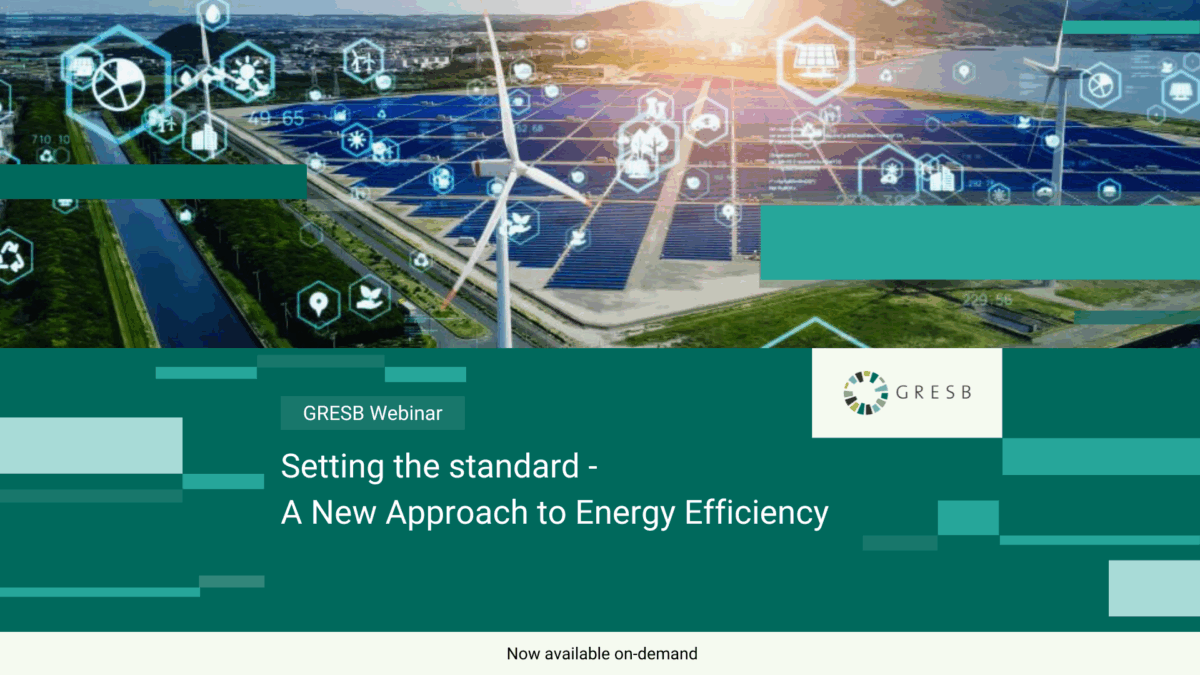Energy efficiency continues to be a top priority for the real estate sector. However, as more assets achieve high levels of operational performance, the conventional focus on year-on-year reductions in energy use intensity (EUI) has revealed limitations. Recognizing this, the GRESB Foundation has revised its energy performance scoring for 2025 to more effectively account for both continuous improvement and operational excellence.
GRESB discussed the technical basis and strategic reasoning behind this update in its recent webinar “Setting the Standard: A New Approach to Energy Efficiency.” The session featured expert insights from Charles van Thiel, Director of Real Estate Standard at GRESB; Parag Cameron-Rastogi, Director of Real Asset Analytics at GRESB; and Jamie Kono, vice chair of the Std. 100 committee in ASHRAE. Together, they explored how this new methodology works, how it is grounded in global benchmarks, and what it means for participants aiming to improve or maintain high-performance building operations.
Watch a recording of the webinar and read more insights from the conversation below.
Why update the scoring methodology?
The GRESB Foundation’s broader goal is to support market participants in demonstrating progress in building performance—particularly in areas like energy use and carbon reduction. In past years, the Standard emphasized “like-for-like” improvements in EUI, rewarding assets that demonstrated year-on-year reductions.
However, this model can no longer serve all assets equally. Some buildings have already achieved very high levels of efficiency and are no longer expected to deliver further annual reductions. Without an alternative route for recognition, these assets risk being penalized despite strong performance.
To address this, the 2025 Real Estate Standard introduces a dual-pathway approach:
- Performance improvement: Recognizes year-on-year improvement in energy use intensity.
- Absolute performance: Rewards assets that meet or exceed defined efficiency thresholds based on absolute energy use intensity.
This structure ensures that all assets—whether progressing or maintaining strong performance—are assessed fairly and incentivized appropriately.
ASHRAE 100: A new technical foundation
To support the absolute performance assessment approach, GRESB aligned its thresholds with ASHRAE Standard 100:2024—a global benchmark that defines EUI targets by building type and climate zone. This integration brings technical rigor, transparency, and global applicability to the updated standard.
During the webinar, Parag Cameron-Rastogi explained the process behind adopting ASHRAE 100. By referencing a recognized framework with thresholds based on climate data and operational performance, GRESB ensures that its new scoring method is both realistic and ambitious.
ASHRAE 100 currently includes targets for 55 building types across 16 climate zones. GRESB has mapped these categories to its reporting framework, and internal analysis showed that more than 95% of assets reported to GRESB in 2023 and 2024 have a corresponding ASHRAE 100 EUI target.
Coverage and implementation
GRESB’s analysis of its own reporting dataset revealed that:
- Some of the best-performing market segments have up to 12% of assets meeting the ASHRAE thresholds.
- Globally, the percentage of assets currently meeting these thresholds ranges between 5 and 10%, depending on region and sector.
This confirms that the thresholds are ambitious—but not out of reach. The targets reflect what can be achieved using current technologies and management practices, and they are designed to motivate continuous action where improvement is still possible.
For asset types not yet covered by ASHRAE 100 (such as self-storage or indoor parking), the GRESB Foundation is exploring further development in collaboration with the ASHRAE 100 committee to increase coverage over time. These efforts include the potential use of internal data to define additional thresholds in the future.
GRESB Participants can now view the applicable ASHRAE values directly in the Asset Portal during reporting, making it easier to identify how each asset aligns with the updated methodology.
Looking ahead
This year’s updates mark a fundamental shift in how energy efficiency is evaluated within the GRESB Standards. The introduction of absolute thresholds provides a new mechanism for recognizing high-performing assets and signals a broader move toward scoring based on demonstrated outcomes. While the current focus is on energy use, the dual-pathway model lays the foundation for similar advancements in other performance areas.
Looking forward, the GRESB Foundation is actively exploring how absolute thresholds can be extended to topics such as greenhouse gas emissions, water consumption and waste reduction. Future updates to the Standard may also include changes to scoring weights, reinforcing the emphasis on measurable results and operational impact. This evolution reflects GRESB’s long-term ambition to drive meaningful change by aligning reporting with the data that matters most.
Setting the Standard – A New Approach to Energy Efficiency
As the real estate sector advances toward more rigorous energy efficiency standards, understanding the shift from relative to absolute performance has become essential.
Gain insights into how energy performance is now assessed, why the new dual-pathway model fosters fairer benchmarking, and what it means for investors and high-performing assets alike.
